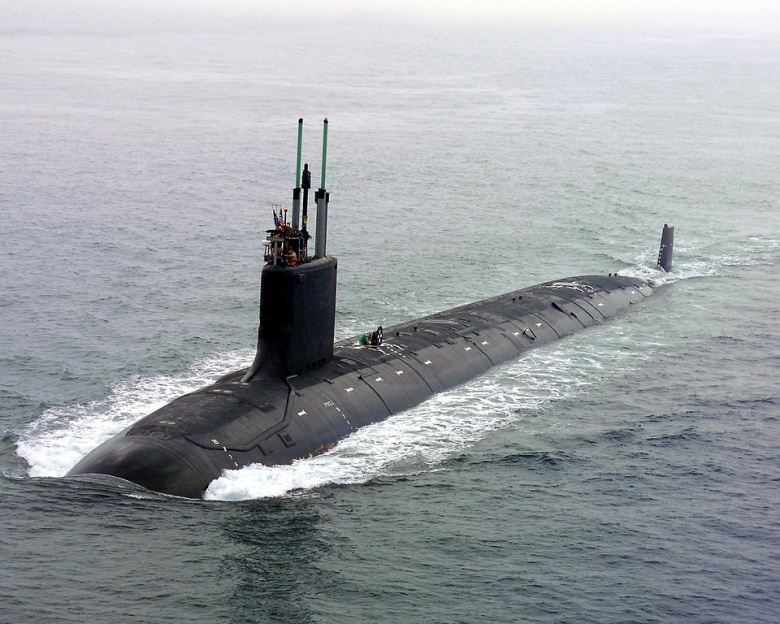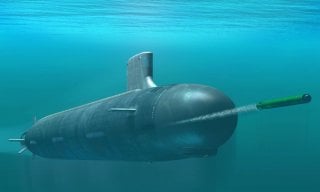Virginia-Class: The U.S. Navy Submarine Russia and China Fear Most
As the latest class of nuclear-powered fast attack submarines in the Navy, the Virginia-class is top-of-the-line. New variants of this class mean they will continue to improve.
Meet the Virginia-class submarine: As tensions between Washington and Beijing continue to rise, the U.S. Navy’s fleet of submarines will become more prominent in America’s sea-based defense apparatus.
Just a few days ago, the Pentagon revealed that an Ohio-class submarine was deployed to join U.S. Central Command’s area of operations amidst the Israel-Hamas War. If other non-state actors expand the ongoing war in the Middle East, additional U.S. vessels will likely make their way to the region.
The Navy’s latest Virginia-class attack submarine block is expected to elevate the service’s capabilities once commissioned. However, the Block V program was delayed by two years over the summer due to staffing issues. According to the Government Accountability Office, major roadblocks stand in the way of completing this upcoming class of submarines.
A brief history of the Virginia-class:
As the latest class of nuclear-powered fast attack submarines in the Navy, the Virginia-class is top-of-the-line.
Initially designed as a cheaper alternative to the Seawolf-class vessels, 21 Virginia subs are already in service.
The Seawolf was canceled only after three of these submarines were constructed. Costing at nearly $3 billion per unit, this class was viewed as unsustainable.
Comparably, the Virginia-class boats cost around $1.8 billion.
Engineers could reduce prices by using more “commercial off-the-shelf” materials. The Virginia-class subs were designed to be versatile with blue water duties and littoral coast operations, including intelligence missions involving special forces like the Navy SEALs.
In the early 1990s, the Virginia class became the first Navy warship to be developed with 3D visualization technology. Despite using computer-aided advanced technology to construct the vessels, design problems for manufacturer Electric Boat (a division of General Dynamics) occurred, contributing to delays in production.
The first Virginia-class ship was completed in 2001. To this day, the sole engineers behind these vessels are Electric Boat and Newport News Shipbuilding, as they are the only facilities able to construct nuclear-powered SSNs.
News variants = enhanced capabilities:
The majority of the 21 Virginia-class submarines in service are Block I-III. Only three Block IV are in use today, although several more are undergoing construction.
These large ships displace nearly 8,000 tons and feature hull lengths measuring roughly 377 feet. Since the Virginia-class subs are nuclear-powered, they can travel at top speeds of around 25 knots.

Block III boats are fitted with designs to help lower acquisition costs and enhance flexibility, including replacing 12 vertical launch tubes for Tomahawk land attack missiles with two tubes capable of firing larger payloads. These submarines also are equipped with a fly-by-wire ship control system that enables for improved shallow-water ship handling.
The Virginia Payload Tubes incorporated to the Block III variants simplify construction, provide for greater payload flexibility and reduce acquisition costs.
Meet the Block V
While all of the Virginia-class variants provide key capabilities to the Navy, the newest Block V variant stands out.
A recently released Congressional Research Service Report detailed additional changes that the Block V variant will possess: “Most Virginia-class boats procured in FY2019 and subsequent years are to be built with the Virginia Payload Module (VPM), an additional, 84-foot-long, mid-body section equipped with four large-diameter, vertical launch tubes for storing and launching additional Tomahawk missiles or other payloads.”
Additionally, the new variant is expected to feature a seabed warfare variant designed to interact with the sea floor.
Why is the Block V variant delayed?
The Block V Virginia-class variants will also be much quieter underwater than its sister ships. Its low acoustic signature has been described by Naval News: “On the sonar front the Block Vs are expected to receive the Large Vertical Array (LVA) flank sonars. These are in addition to the six ultra-modern Light Weight Wide Aperture Arrays (LWWAA) which are placed along the submarine’s side.”
While Block V capabilities are unparalleled, these variants will be slow to actually enter service with the Navy. Since shipbuilders are tasked with constructing both Virginia-class and one Columbia-class submarine each year, the workload may be too ambitious.

According to independent government auditors, the shipbuilding process of this new variant has continued to “degrade” due to timing issues and staffing deficiencies. As detailed in the report released by GAO, “While the fixed price incentive contract set target and ceiling prices for each submarine, program officials reported that the VCS shipbuilders have not met the work efficiency and material cost estimates that informed the target pricing. Consequently, the Navy plans to request more funds to complete Block V, as its prior budget requests covered the target prices, but not up to the ceiling prices.”
Despite the delays associated with the newest Block V Virginia-class submarines, these ships will undoubtedly enhance the Navy’s sea-based capabilities. In addition to the increasing tensions between Washington and Beijing in the South China Sea, Russia’s ongoing invasion of Ukraine and Israel’s war against Hamas indicate a rise in global conflicts. The readiness and formidability of the Navy’s arsenal are essential to preserving U.S. security.
Maya Carlin is an analyst with the Center for Security Policy and a former Anna Sobol Levy Fellow at IDC Herzliya in Israel. She has by-lines in many publications, including The National Interest, Jerusalem Post, and Times of Israel. You can follow her on Twitter: @MayaCarlin.
Image Credit: Creative Commons.


